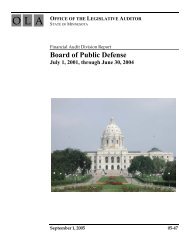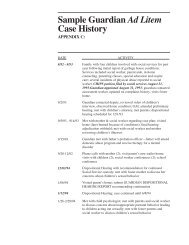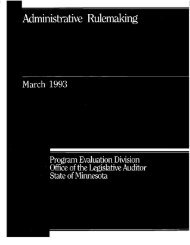Occupational Regulation - Office of the Legislative Auditor
Occupational Regulation - Office of the Legislative Auditor
Occupational Regulation - Office of the Legislative Auditor
Create successful ePaper yourself
Turn your PDF publications into a flip-book with our unique Google optimized e-Paper software.
8 OCCUPATIONAL REGULATION<br />
that results in a regulatory scheme that protects pr<strong>of</strong>essionals more effectively<br />
than it protects <strong>the</strong> public.<br />
Reforms<br />
adopted in<br />
Minnesota<br />
include<br />
requirements<br />
for public<br />
representation<br />
on regulatory<br />
boards.<br />
To address <strong>the</strong>se concerns, many states began to incorporate one or two<br />
non-pr<strong>of</strong>essional “public members” into <strong>the</strong>ir regulatory boards. In Minnesota,<br />
<strong>the</strong> Legislature began this reform in <strong>the</strong> early 1970s by placing public members on<br />
each <strong>of</strong> <strong>the</strong> health boards. Public members are presumed to bring <strong>the</strong> consumers’<br />
interests to <strong>the</strong> boards, open up a direct line <strong>of</strong> public involvement to <strong>the</strong> activities<br />
<strong>of</strong> <strong>the</strong> board, and guard against overly sympa<strong>the</strong>tic disciplinary actions against<br />
pr<strong>of</strong>essionals found to be at fault. Historically, pr<strong>of</strong>essionals have argued against<br />
<strong>the</strong> inclusion <strong>of</strong> many public members on regulatory boards on <strong>the</strong> grounds that<br />
persons not trained in a given field would not have <strong>the</strong> knowledge and experience<br />
necessary to fully understand <strong>the</strong> technical issues that boards <strong>of</strong>ten face. 24 The<br />
obvious counter-argument is that <strong>the</strong> U.S. judicial system makes extensive use <strong>of</strong><br />
ordinary citizens in jury trials that decide on any number <strong>of</strong> complex, technical,<br />
and scientific matters. 25<br />
There is some evidence supporting <strong>the</strong> notion that public members streng<strong>the</strong>n<br />
regulation. One study found a relationship between increased public membership<br />
on regulatory boards and <strong>the</strong> likelihood that state legislatures enact fewer<br />
“nonsense” entry requirements for regulated pr<strong>of</strong>essionals, such as “good moral<br />
character,” which can only serve as additional fencing mechanisms for<br />
pr<strong>of</strong>essionals. 26 Ano<strong>the</strong>r study found that “<strong>the</strong> proportion <strong>of</strong> public members ...<br />
[has a] positive effect on serious disciplinary actions, suggesting that public<br />
members may be effective at improving <strong>the</strong> disciplinary performance <strong>of</strong> health<br />
occupational licensing boards.” 27<br />
Although <strong>the</strong> inclusion <strong>of</strong> one or two public members on regulatory boards is<br />
widespread, some feel that <strong>the</strong> present state <strong>of</strong> public representation is inadequate.<br />
Calls continue to be made for increasing public membership on regulatory boards.<br />
For example, <strong>the</strong> first recommendation made in a recent report by <strong>the</strong> Arizona<br />
<strong>Auditor</strong> General was: “The Legislature should consider increasing public<br />
membership on all health regulatory boards to 50 percent.” 28 University <strong>of</strong><br />
Minnesota pr<strong>of</strong>essor Morris M. Kleiner calls for a majority <strong>of</strong> public members on<br />
regulatory boards. 29 Also, a recent report issued by <strong>the</strong> Pew Health Commission<br />
included <strong>the</strong> recommendation that “individual pr<strong>of</strong>essional boards in <strong>the</strong> states<br />
must be more accountable to <strong>the</strong> public by significantly increasing <strong>the</strong><br />
representation <strong>of</strong> public, non-pr<strong>of</strong>essional members. Public representation should<br />
be at least one-third <strong>of</strong> each pr<strong>of</strong>essional board.” 30<br />
24 Schmitt and Shimberg, Demystifying <strong>Occupational</strong> and Pr<strong>of</strong>essional <strong>Regulation</strong>, 30.<br />
25 Ibid., 30.<br />
26 Elizabeth Graddy, and Michael B. Nichol, “Public Members on <strong>Occupational</strong> Licensing<br />
Boards: Effects on <strong>Legislative</strong> Regulatory Reforms,” Sou<strong>the</strong>rn Economic Journal 55, no. 3 (January<br />
1989): 610-625.<br />
27 Elizabeth Graddy and Michael B. Nichol, “Structural Reforms and Licensing Board Performance,”<br />
American Politics Quarterly 18, no. 3 (July 1990): 394.<br />
28 Arizona <strong>Auditor</strong> General, “The Heath Regulatory System” (Report #95-13; December 4,<br />
1995), 13.<br />
29 Kleiner and Gordon, “The Growth <strong>of</strong> <strong>Occupational</strong> Licensing,” 11.<br />
30 Finocchio et al., Streng<strong>the</strong>ning Consumer Protection, 16.








